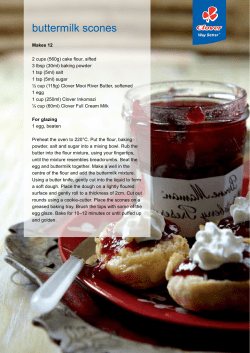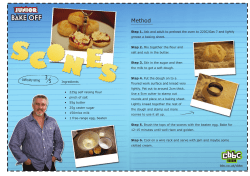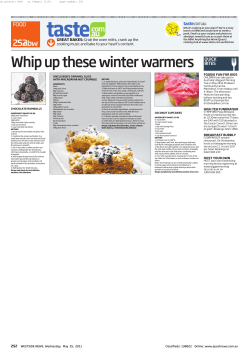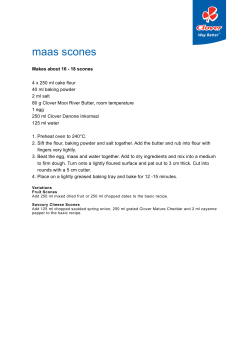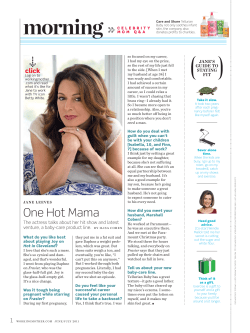
Dutch Baby Grows Up
Dutch Baby Grows Up A cross between a popover and a giant, eggy pancake, a Dutch Baby bakes in a skillet in a “brisk oven” (as an old recipe we found puts it). It puffs up spectacularly and then, moments out of the oven, deflates to form a bowl with crisp sides and a thin, custardy bottom. It’s finished with a squeeze of lemon juice and a generous dusting of confectioners’ sugar. This pancake is thought to come from Germany, not Holland—the name is a corruption of “Deutsch.” The “baby” is usually traced to Manca’s Café in Seattle, famous for more than 50 years for the small (hence, baby) oven-baked pancakes it dubbed Dutch Babies. Over the years, the baby has grown up: Today it’s inevitably large. That suited me. A big, puffy pancake was just what I had in mind. BY MARÍA DEL MAR SACASA Most recipes have you whisk together a 1-to-1 ratio of flour to milk with several eggs, pour the mixture into a heavily buttered skillet, and bake for 20 minutes. Where ordinary pancakes call for baking soda and powder, Dutch Babies rely on the conversion of water to steam for their lift—the milk, eggs, and butter in the batter all contain substantial amounts of water. Perhaps because the oven temperature, amount of batter per skillet, and skillet type and size varied widely in the recipes I found, so did the results of my first set of tests. Some Dutch Babies had soft sides, others thick and soggy bottoms; others never rose above the skillet rim. I wanted a puffy, well-risen pancake (large enough to serve four people) with crisp sides and a tender bottom. To feed four, I’d need enough batter for a 12-inch skillet. Most recipes call for ½ cup flour, ½ cup milk, and 3 eggs, but many—especially older ones—are !" maddeningly vague about skillet size. I poured the batter into a 12-inch skillet but came up short. Keeping the flour-to-milk ratio constant, I tested increasing amounts, and eventually concluded that 1¼ cups of each gave me the right volume for the pan. Since I’d more than doubled the milk and flour, logic dictated I double the eggs as well. But when I did so, the bottom thickened, and the final result tasted like a fluffy omelet instead of a proper pancake. I scaled back the eggs one by one and, despite the extra flour and milk, found that three still sufficed. I wanted my baby to be big. I figured separating the eggs and beating the whites to stiff peaks would ensure height. Instead, I produced a soufflé-like concoction with a lumpy, foamy middle. Worse, the edges were no taller than before. Next, I experimented with baking temperature, going up and down the thermometer like a New England winter’s day: At 450 degrees, I got the highest rise without any burning. To ensure that the batter rose evenly, I tested various skillets. A traditional cast-iron skillet worked well, but I had even better luck with an ordinary skillet, as its gently sloping sides promoted an even rise. Now if only I could get the sides to crisp. Knowing that fat makes baked goods tender, I wondered: If I replaced the whole milk in my Dutch Baby with skim milk, might less fat translate to more crispness? Indeed it did. Next, I replaced ¼ cup of the flour with an equivalent amount of cornstarch, an ingredient known for its crisping powers. But I wasn’t quite done. Past experience had taught me that a hot skillet would give the batter a head start on crisping. Some recipes preheat the skillet on the stovetop just long enough to melt the 3 tablespoons of butter that grease the pan. !! " " # $ % & ! " ' ( ) * + , - . / * ' 0 * + 1 2 0 * ! 3 ! " # $ # !"#$%&'()*+,-*.//&&&01 00234256&&&0748&9: But I got better results preheating the pan in the oven until sizzling—though the knob of butter scorched in the blazing-hot skillet. I tried vegetable oil, which has a higher smoke point, and solved one problem but caused another: Everybody missed the taste of butter. The next time, I greased the pan with 2 tablespoons oil (be sure to brush the sides, too) and stirred 1 tablespoon melted butter into the batter. For a final flavor tune-up, I whisked a teaspoon of vanilla extract and 2 teaspoons of lemon zest into the batter. Whoa, baby! DU T C H B ABY Serves 4 You can use whole or lowfat milk instead of skim, but the Dutch Baby won’t be as crisp. For a treat, serve with an assortment of berries and lightly sweetened whipped cream. STEP BY STEP Baby Steps Look, Ma, no leavener! From liquid batter to puffy popover, here’s how you make a Dutch Baby. 1. The entire interior surface of the pan—including the sides—is brushed with vegetable oil. 1 cup all-purpose flour ¼ cup cornstarch 2 teaspoons grated zest and 2 tablespoons juice from 1 lemon 3 large eggs 1¼ cups skim milk (see note) 2. To initiate the big rise, the greased pan is heated before the batter is poured in. 1 tablespoon unsalted butter, melted and cooled 1 teaspoon vanilla extract 3 tablespoons confectioners’ sugar 1. OIL SKILLET Adjust oven rack to middle position and heat oven to 450 degrees. Brush surface and sides of large skillet with oil. Place skillet on oven rack and heat until oil is shimmering, about 10 minutes. 2. MIX BATTER Meanwhile, combine flour, cornstarch, lemon zest, and salt in large bowl. Whisk eggs in another bowl until frothy and light, about 1 minute. Whisk milk, butter, and vanilla into eggs until incorporated. Whisk one-third of milk mixture into flour mixture until no lumps remain, then slowly whisk in remaining milk mixture until smooth. 3. BAKE AND SERVE Carefully pour batter into heated skillet and bake until edges of Dutch Baby are deep golden brown and crisp, about 20 minutes. Transfer skillet to wire rack and sprinkle Dutch Baby with lemon juice and confectioners’ sugar. Cut into wedges. Serve. Homemade sausage in 15 minutes? Yes, you can. BY D I A N E UN G ER B REAKFAST sausage patties commit a multitude of sins: too sweet or too salty, too bland or too highly seasoned, too greasy. Making our own would surely taste better, but the recipe would have to be simple: no lengthy ingredients list and no complicated methods (we wouldn’t be grinding our own meat, thank you very much). We started by flavoring ground pork (avoid lean, which is neither fatty nor flavorful enough) with classic breakfast sausage flavors: minced garlic, dried thyme and sage, and cayenne for a touch of heat. One tablespoon of maple syrup gently sweetened the patties and was appropriate for breakfast, as were the mild flavors. We kneaded the meat and spices with our hands, taking care not to overmix, which would toughen the meat. To form even patties, we greased a ¼ -cup measure and quickly scooped and plopped 16 patties onto a sheet pan. We covered the patties with plastic wrap and pressed lightly on each patty. After a side-by-side tasting, we opted for frying in butter, not oil, for its flavor and richness. STORE-B OU GHT 2 tablespoons vegetable oil 1 teaspoon salt EASIER THAN YOU THINK Breakfast Sausage HOMEMADE BREAKFAST SAU SAG E Serves 8 3. Like magic (or like a giant popover, which it resembles), the Dutch Baby balloons in the oven. Avoid lean or extra-lean ground pork; it makes the sausage dry, crumbly, and less flavorful. 2 pounds ground pork (see note) 1 garlic clove, minced 1 tablespoon maple syrup Pick up ground pork at the store. You’ve got everything else you need at home to make these easy sausages. 1. MIX SAUSAGE Combine pork, garlic, syrup, sage, thyme, salt, pepper, and cayenne in large bowl. Gently mix with hands until well combined. Form mixture into 2½ -inch patties, about ½ inch thick. (You should have 16 patties.) 2. BROWN SAUSAGE Melt 1 tablespoon butter in large nonstick skillet over medium heat. Cook half of patties until well browned and cooked through, 3 to 5 minutes per side. Transfer to paper towel–lined plate and tent with foil. Wipe out skillet. Repeat with remaining butter and patties. Serve. 2 teaspoons dried sage ½ teaspoon dried thyme 1 teaspoon salt 1½ teaspoons pepper ⅛ teaspoon cayenne pepper 2 tablespoons unsalted butter 4. The Dutch Baby will deflate after it sits a few minutes. Don’t worry—it’s supposed to. Dust it with confectioners’ sugar and enjoy. The raw sausage patties can be refrigerated, covered, for 1 day or frozen for up to 1 month. To cook frozen patties, proceed with step 2, cooking patties for 7 to 9 minutes per side. MAKE AHEAD: TEST KITCHEN TECHNIQUE Perfect Patties THE AMERICAN TABLE Covert Influence “German food and food influences can easily escape notice,” Patricia Mitchell writes in German Cooking in America. “German cooking was integrated long ago. Because of that, we think of many foods of German origin as ‘American.’” Cases in point: hot dogs, hamburgers, jelly doughnuts, potato salad, mustard, pretzels, pot roast, and that American diner display icon— Black Forest Cake. We fought the Germans, of course, in two successive world wars. At that time, many foods of German origin shed their past and raced to become full-fledged U.S. citizens. 1. A greased ¼-cup measure makes 16 uniform patties with a minimum of work and mess. 2. Cover with plastic wrap, then use your palm to gently flatten each sausage patty. !"#$%&$'()&$*+!"#$#!"##$%&'"#()*+, !"#$%&'()*+,-*.//&&&01 !" 00234251&&&0647&89
© Copyright 2025


